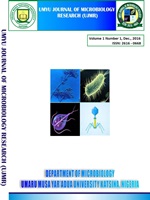Optimization of Cellulase Activity by Aspergillus niger and Penicillium chrysogenum using Some Agricultural Wastes
DOI:
https://doi.org/10.47430/ujmr.1611.025Keywords:
Optimum, Cellulase, A. niger, P. chrysogenum, OptimizationAbstract
Cellulases are enzymes used in various manufacturing processes and their production is faced with a number of challenges including high cost of raw materials, low product recovery due to the nature of microbial cells and unfavorable growth conditions leading to high cost of the finished products. This study was therefore designed to investigate the optimum physicochemical conditions that could support the production of large amount of cellulase by Aspergillus niger and Penicillium chrysogenum using agricultural wastes as substrates. Each of the fungal species was grown in a mineral salt media containing either of paper, sugar cane bagasse or wheat bran as sole carbon source at various concentrations. Cellulase activity was observed to be optimum at 5 % w/v using the substrates after 96 hours incubation. The effect of temperature and pH were then assessed and wheat bran was shown to support optimum cellulase activity (5.36 IU and 3.62 IU) at pH 5 and temperature of 30°Cusing both organisms. Using paper however, the optimum enzyme activity (1.28 IU and 1.26 IU) was observed at pH 6 and temperature ranging from 35°C (A. niger) to 45°C (P. chrysogenum). pH 5 was observed to be optimum for cellulase activity using sugar cane bagasse but P. chrysogenum performed better (1.01 IU) at 40°C than A. niger (0.91 IU) at 50°C. Cellulase activity using the two latter substrates was significantly (p< 0.05) lower than that of wheat bran under the said conditions. This study therefore, revealed that the two fungal species are excellent cellulase producers under optimum conditions of 30°C and pH 5 using wheat bran at 5% concentration; hence their potentials for large scale cellulase production.
Downloads
References
Ali, S. A. Sayed, R.T. Sarker, D. and Alau,R. (1991). Factors affecting cellulose production by Aspergillus niger and Aspergillus terrus using water Hyacinth, World Journal of Microbial Biotechnology, 7 :62- 66
Awan, J.A. and S.U-Rahman, (2002). Microbiology Manual, p. 63. Unitech Communications, Faisalabad- Pakistan
Baig ,M.M.V., M.L.B. Baig, M.I.A., Baig and Y. Majeda (2004). Saccharification of banana agro waste by cellulolytic enzymes . Afr J.Biotechnol.,3:447-450.
https://doi.org/10.5897/AJB2004.000-2088
Beldman ,GM Searle -Van leeuwen,F Rombouts And F Voragen (1985). The cellulase of Trichodermaviride; purification ,characterization and comparison of all detectable endoglucanase, exoglucanase and Beta glucosidases, Eur J. Biochem: 18:146-301
https://doi.org/10.1111/j.1432-1033.1985.tb08653.x
Bergquist., V. Teo'O and M.Gibbs.(2002). Expression of Xylanase enzymes from thermophilic microorganisms in fungal host. Extremophiles.,6:177- 184.
https://doi.org/10.1007/s00792-001-0252-5
Bhat, M. K. and Bhat, S. (1997). Cellulose degrading enzymes and their potential industrial applications, Biotechnological Advances, 15: 583-620.
https://doi.org/10.1016/S0734-9750(97)00006-2
Bukar A, Abbas M. I, Milala M. A, Ali A. A.(2016). Cellulase production by Aspergillus niger, Trichoderma harzianum and Penicillium chrysogenum using some selected agricultural wastes. Discovery Journal, 2016, 52(250), 1947-1962
Cappuccino, J.G. and N. Sherman, (1999). Microbiology: A Laboratory Manual, 4th Ed., pp: 199-204. Addison Wesley Longman, Inc.Harlow, England
Coughlan, M P. andLjungdahl, L. G. (1988).Comparative Biochemistry of Fungal and Bacterial Cellulolytic Enzyme Systems.FEMS Symposium, Vol. 3 (Biochem.Genet.Cellul.Degrad.), Pp. 11-30, ISSN: 0163-9188.
Dillon, Aldo. Celulases.In: SAID, S.; PIETRO, R. C. L. (2004).Enzimascomo magentesbiotecnológicos. RibeirãoPreto: Legis Summa, p. 243- 270.
Gbekeloluwa ,B.O and Moo Young (1991). Production and properties of glucosidases by Neurosporasitophila. World Journal Microbiology and Biotechnology7:4- 11
https://doi.org/10.1007/BF02310911
Gilkes N.R, M T Langsford , W.W Wakarchuk, D.G Kilbum , RC miller and R A J Warren (1984).the cellulase system of Cellulomonas finni. Journal of General microbiology 130:1367-1376
https://doi.org/10.1099/00221287-130-6-1367
Milala, M.A., Shugaba, A., Gidado, A., Ene, A.C. and Wafar, J.A., (2005). Studies on the use of Agricultural waste for cellulase Enzyme production by Aspergillusniger. Journal of Agriculture and Biological Science 1 (4):325 -328.
Malik, B.S., (1996). A Laboratory Manual of Veterinary Microbiology, Part III. Pathogenic Bacteriology and Mycology, 4th Ed., pp: 137- 46.Satish Kumar Jain for CBS Publishers and Distributors.
Ogundero,V W.(1992) .The production and activity of hydrolytic exoenzymes by toxigenic species of Aspergilllus from garri. Nigeria Journal of Science 16(1- 2):11-20
Omojasola, P.F. and Jilani, O.P.(2008).Cellulase production by Trichoderma longi Aspergillus niger and Saccharomyces cerevisiae cultured on waste materials from oranges. Pakistan Journal of Biological Sciences 11(20):2382-2388.
https://doi.org/10.3923/pjbs.2008.2382.2388
Sandgren, M. and Hiberg, J. S. (2005). Structural and Biochemical Studies of GH Family 12Cellulases: Improved Thermal Stability and Ligand Complexes. Progress in Biophysics and Molecular Biology, Vol. 89, No.3, (November 2005), p. 246-291, 2005.ISSN:0079-6107.
https://doi.org/10.1016/j.pbiomolbio.2004.11.002
Steiner, J. C Sodia and J Enzaguire (1994).Culture condition for enhanced cellulase production by Aspergilllusniger .World Journal of Microbiology andBiotechnology: 10:280-284
https://doi.org/10.1007/BF00414863
Zhang, Y.H. and Lynd, L.R. (2006).A functionally based model for hydrolysis of cellulose byfungal cellulase.Biotechnology and Bioengineering, Vol.94, No. 5, Pp. 888-898, ISSN 0006-3592.
Downloads
Published
How to Cite
Issue
Section
License
Copyright (c) 2023 UMYU Journal of Microbiology Research (UJMR)

This work is licensed under a Creative Commons Attribution-NonCommercial 4.0 International License.




